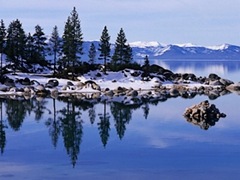 Steeped in controversy yet the theory is simple; if garlic and lemon makes it palatable then it escapes the invasive label. If it’s too small to barbeque it’s destined to be fought tooth and nail.
Steeped in controversy yet the theory is simple; if garlic and lemon makes it palatable then it escapes the invasive label. If it’s too small to barbeque it’s destined to be fought tooth and nail.
The exception being Rock Snot, which despite urging from the President’s Council on Physical Fitness, we avoid salad like the plague so there’s little mystery in why we’re determined to eradicate it.
The Jewel of the Sierra Nevada, Lake Tahoe, may soon dwarf anything on the B.A.S.S. circuit – what with it being the second deepest lake in the US, proximity to the glitz and glamour of Reno, and filled with defenseless fat Mackinaw, Rainbow, and Brown trout just waiting to serve as forage for the Largemouth Bass…
That new world record from Japan is on unsteady ground in light of this high elevation jewel and its gradually warming water – two degrees in the last seventy years, and projected to warm further in the next decade.
Likely introduced by anglers in the Tahoe Keys neighborhood of South Lake Tahoe in the early 1990s, bass and bluegill appear to be spreading throughout the lake slowly but steadily.
The fish have overrun the Keys and have been found in more than half of the marinas and lagoons sampled around the lake.
The current residents were all introduced by Man, with eradication of the native Lahontan Cutthroat following shortly thereafter, making the Largemouth and Bluegill introduction a “double negative” – halting efforts to restore the native fishery.
A cold water Largemouth is fine table fare – and other than the Elvis impersonator in the V-8 equipped “party barge” next to you, little will change other than the quarry.
A powerpoint presentation suggests that the shallow marinas offer warmer water – and further development near the lake shore assists the warming process, with portions of the lake warming as much as three more degrees, allowing for a longer growth season and approaching temperatures Largemouth find attractive.
If current warming trends persist – about 2070 we’ll be hosting some spectacular fishing.
